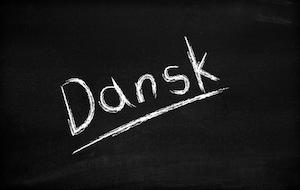Auditory & Visual Language Learning: Our Danish Experience
 Language learning experts continue to discuss the relative benefits of auditory versus visual learning. This is not about "learning styles", the theory - debunked by cognitive psychologists - that you're born with a way of learning that's best for you.
Language learning experts continue to discuss the relative benefits of auditory versus visual learning. This is not about "learning styles", the theory - debunked by cognitive psychologists - that you're born with a way of learning that's best for you.
Young children learn their first language(s) by listening to and repeating the words, phrases and sentences they hear their parents, caregivers, siblings and friends speak.
They can't read and write yet, but they do get a lot of feed-back from others in the form of explanations, corrections, etc.
In most cases, foreign language learning by older children and adults occurs somewhat differently. They already have a native language which they can read and write. This gives them an additional learning tool that can, however, both help and interfere.
Clearly adults can learn a new language just by listening. At the beginning it helps to hear the translation in their native language.
This is the method used by audio-only programs such as Michael Thomas and Pimsleur, the latter being the one we are most familiar with. (See also our reviews of Pimsleur German and Russian)
Language learning also occurs visually. One way is by using a combination of images and written words. Language books and dictionaries are the backbone of that approach. Apps and online learning programs typically combine audio, images, and words in written form. Some use a “teaching language,” others don't (such as Rosetta Stone, Lingualia, and others.)
Most other programs, including Duolingo, Memrise, Babbel, GamesforLanguage, etc. rely on reading (and writing) the foreign words, sometimes also together with images.
This works well when the foreign and teaching language use the same alphabet and have similar pronunciation rules. Language learning becomes more challenging when those are different.
Different Alphabets
For English speakers learning to read and write languages that don't use the Latin alphabet is quite a challenge.
 A few years ago, in preparation for a trip to Japan and China, we used the Pimsleur method to learn some basics. Learning Chinese characters was not even one of our goals.
A few years ago, in preparation for a trip to Japan and China, we used the Pimsleur method to learn some basics. Learning Chinese characters was not even one of our goals.
As we reported elsewhere, we did not progress much beyond the usual greetings, please, thank you, etc. However, we drilled the Chinese numbers quite a bit and found knowing them very useful.
Learning other alphabets, e.g. Cyrillic (see picture above), Arabic, and others is easier for English speakers, than learning Asian writing systems.
In either case, you have to know the new writing systems before you can acquire “comprehensible input” through reading. Until then you can only learn though listening (or using transliteration, as is often done with Japanese, Chinese, and others).
Different Pronunciation Rules
English speakers sometimes forget how difficult it is for foreigners to learn the often inconsistent pronunciation rules of the English language.
Even children learning English as a native language have a tough time. We see it with our young grandchildren, as they are sounding out words like “through,” “though,” “tough,” “eight,”“height,” “weird,” or try to spell them.
 On the other hand, German, Spanish, Italian, and French (the other four languages on our GamesforLanguage site) do have rather consistent pronunciation rules, or as linguists may call it, more or less "phonetic spelling."
On the other hand, German, Spanish, Italian, and French (the other four languages on our GamesforLanguage site) do have rather consistent pronunciation rules, or as linguists may call it, more or less "phonetic spelling."
This is certainly true for German. Once English speakers can get past the American “r” and “l”, get the vowels and umlauts correctly, figure out the “ch” and end “g”, there is not much mystery remaining in German pronunciation.
Among the Romance languages, Italian and Spanish may be even easier, as long as you remember the spelling of the “k” sound at the beginning of words, and a few others.
For example: “when?” translates to “quando?” in Italian and “¿cuándo?” in Spanish; but “what?” is “che cosa?” in Italian, and “¿qué?” in Spanish. Aside from that, there's a strong correspondence between sound and spelling in both languages.
And yes, French has a lot of accents and letters that are not pronounced, which may make writing more difficult, but reading not that much.
Once you learn a few of the basic rules, you can figure out how to pronounce the words, even if you may not always succeed. In our experience to date, this is not at all the case with Danish.
Our Danish Language Learning Experience
In preparation for a trip to Denmark later this year, we have started to learn Danish. Because it's a Germanic language, we thought learning Danish would be quite easy.
 For the last few weeks we have been using Duolingo and Memrise (and lately also Pimsleur). On Duolingo, we are on a 52-day streak doing between 2-4 lessons every day. Peter's fluency is shown as 41%, and with Ulrike ahead in the lessons, her fluency lists as 49%.
For the last few weeks we have been using Duolingo and Memrise (and lately also Pimsleur). On Duolingo, we are on a 52-day streak doing between 2-4 lessons every day. Peter's fluency is shown as 41%, and with Ulrike ahead in the lessons, her fluency lists as 49%.
But we both don't feel at all even close to those percentages and don't feel that we have made much progress in understanding and speaking Danish. Why? Because we have not (yet) figured out most of the correlations between written and spoken Danish.
Different from the four languages (besides English) on our GamesforLanguage site, the Danish pronunciation rules are not so obvious to us.
While we are continuing with Duolingo and Memrise at a somewhat reduced speed, we're experiencing something interesting as we're doing the Pimsleur Danish course. Again, it's not about the persistent myth of learning learning styles.
Simply, with Pimsleur, we can concentrate fully on listening, understanding, and speaking – without having to also consider the correlation between spelling and pronunciation.
Language Learning Insights and Conclusions
The experience with Danish gave us a few insights into the difficulties language learners can have with different pronunciation systems (in addition to different writing systems).
Growing up with or learning German, Dutch, English as children, later adding French, Italian and Spanish, (and trying a few other languages), we had never experienced such a disconnect between the written and spoken language as with Danish.
We both don't find it difficult to do the Duolingo and Memrise lessons and exercises. However, remembering the pronunciation AND spelling of Danish words remains a hit-and-miss affair.
We now find we are making more progress with Pimsleur. Maybe because we only have to remember the translation and pronunciation of words and phrases. Our Danish language learning experience is giving us this important insight: There are clear advantages to focusing on listening/understanding FIRST, when sound and spelling systems are different from the ones we are used to.
Once we have mastered basic vocabulary and with it the Danish pronunciation system, we'll then go on to consciously work on our reading and writing skills.
Have you had similar experiences learning foreign languages with spelling systems quite different from the one(s) you're familiar with? And if so, what tips can you give us?
Bio: Ulrike & Peter Rettig are co-founders of Gamesforlanguage.com. They are lifelong language learners, growing up in several European countries before moving to Canada and the United States. You can follow them on Facebook, Twitter and Instagram, and leave any comments with contact.
